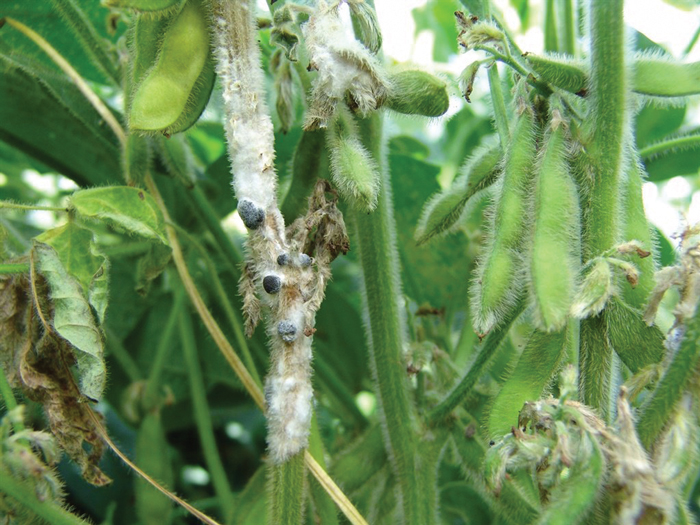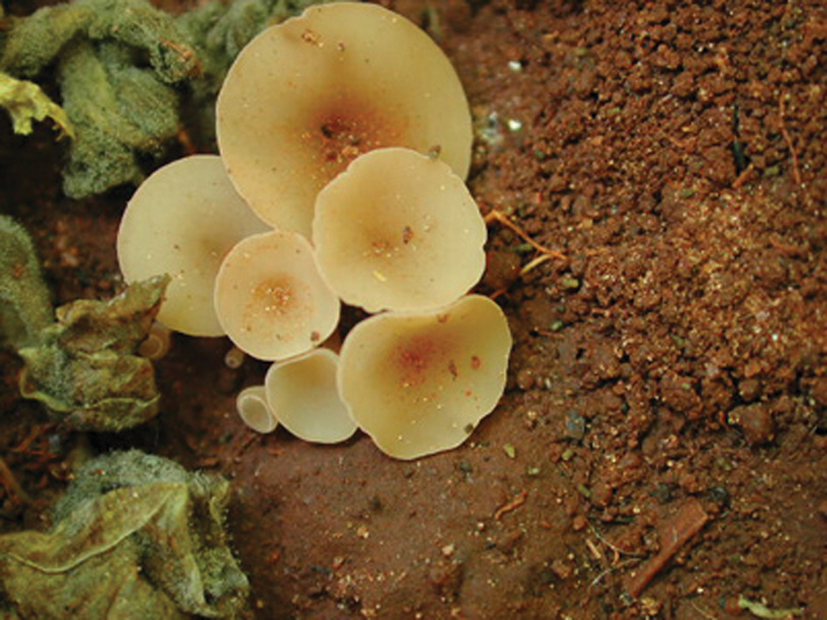
ARC-Grain Crops, Potchefstroom
Sclerotinia stem rot, also known as white mould of soybean, is caused by the fungal pathogen Sclerotinia sclerotiorum and is a common, widespread and destructive disease in soybean production areas in South Africa.
The disease occurs worldwide in soybean fields. It may occur sporadically and vary in severity depending on factors such as climate patterns, soil types, cultivars and cultivation methods. Certain areas are more prone to this disease than others because it is favoured by prolonged wet and cool weather during flowering of the plants. This is the same pathogen that causes Sclerotinia head rot and stem rot of sunflowers discussed in the March issue of SA Graan/Grain.
More than 500 plant species, including a number of crops and weeds, are hosts to S. sclerotiorum. Crops identified as non-hosts include the graminaceous crops such as maize, sorghum, wheat and other small-grain crops. Sclerotinia stem rot was first confirmed in South Africa in 1979, but it occurred long before then. Initially, it was very prominent in soybean fields in the eastern Mpumalanga production areas. From there on it has steadily moved west until it is now found in soybeans throughout the production area as far west as the Northern Cape in irrigated fields.
Losses result directly from loss of yield or indirectly from reduced grain quality, particularly in soybean fields where the plant canopy is dense and prolonged periods of wet weather similar to that during February 2022, are experienced. The disease also manifests as black sclerotia contaminating harvested seed. Local losses due to Sclerotinia on soybean are estimated to be as high as 60% during certain seasons and in certain localities. During dry seasons infections are minimal on the plants, but the sclerotia may still survive in the soil for up to seven years until conditions are once more favourable for infection of the next soybean or sunflower crop. Unfortunately, this disease is extremely difficult to manage and varietal resistance is only a partial solution to the problem.
Symptoms
Infections can occur at any time during flowering of the plants and symptoms of this disease can be observed on leaves, pods, seeds and stems. Visual symptoms occur when the crop canopy between rows closes, resulting in the ideal humid microclimate for infection and disease development. Plants that formed the crop canopy will reveal a cottony, white mycelial mass growing on stems, leaves and/or pods (Photo 1).

Lesions develop on the stem nodes and side branches during or after flowering. These infected stems often become soft and watery and are covered in white, mouldy growth that inspired the alternate name of white mould. As the disease lesions increase and expand, the stem and above plant parts become a greyish green colour, which wilt and die. Scattered dead plants can sometimes be seen standing upright in infected fields, but generally plants are killed in patches within the field.
Stems appear bleached and sometimes shredded from advanced decay. Large, hard and black sclerotia (visually similar to rat faeces) form from the white mycelium growing on plant tissues and in the stem pith (Photo 1). Seeds in diseased pods are usually shrivelled, may be infected by the fungus or are replaced by black sclerotia. The seed is usually contaminated with sclerotia when infected plants are harvested, affecting grain quality.
Disease epidemiology
Infection occurs by ascospores (carpogenic) or mycelial (myceliogenic) germination. For carpogenic infection, the sclerotia germinate near the soil surface during high soil moisture conditions and produce small tan to grey mushroom-like structures, called apothecia (often confused with bird’s nest fungi which also grow in fields – Photo 2). These apothecia produce and release the ascospores into the air where they are carried by air currents to the soybean plant flowers after they have died. Ascospores require a film of water and a nutrient base such as dead or senescing flower tissue to germinate and grow before plant infection takes place.

Dead flowers are infected by the ascospores, which then spread into the stems of the soybean plants. Infection often starts in the stem axils on lodged, senescing flower tissues. Myceliogenic infection occurs when sclerotia germinate in the presence of exogenous nutrients and produce hyphae that invade non-living organic matter. The mycelium subsequently penetrates the host cuticle by mechanical pressure. Infection may also occur through wounds caused by insects or through other injuries on the roots or stem base.
Soybeans are most susceptible to infection by the fungus during early reproductive growth stages where dying flower petals remain attached to the developing pods. A film of water on the plant surface promotes lesion development and increases the amount of tissue damage. Initial disease development requires lengthy periods of cloudy, humid, rainy weather. The greater the density of the plant canopy, the more favourable the environmental conditions for disease. Sclerotia will be formed as the mycelium grows in and on the plant tissues and these sclerotia can survive for a period of up to seven years in the soil, particularly in dry soil conditions.
Management
Variety selection
An important control strategy for Sclerotinia stem rot of soybeans is proper variety selection. It is advisable to choose less susceptible varieties or varieties which have shown high yield under disease pressure when planting in soils with a history of the disease. Certain varieties have been screened by Prof Neal McLaren from the Free State University. None were totally resistant to the disease, but they did vary in susceptibility, with some showing slower disease development over time than others.
Ranking of cultivars according to disease incidence did not correlate over planting dates, seasons or localities, but differential responses of cultivars to the pathogen under different environmental conditions were evident. Using regression statistics to analyse cultivar reactions over different plantings, soybean cultivars could be divided into three different groups, namely those linearly related to disease potential, those highly susceptible even at low disease potentials and those with various degrees of resistance despite increasing disease potentials. The use of slow disease-developing cultivars reduces the speed of the epidemic within a crop.
Canopy management
Under low to moderate disease pressure, white mould infections and growth increase with a decrease in row spacing or if cultivars are planted that readily close the crop canopy. Disease risk reduces on 40 cm row spacing compared to that on 20 cm spacing, except under high disease pressures where row spacing may have no effect on disease severity. Even though narrow rows favour high yield in soybean production, it usually have higher disease levels than wider rows. With this in mind, producers need to find an economical balance between disease repercussions and potential yield.
Crop rotation
A portion of the pathogen population dies yearly because of adverse weather conditions or the activities of other soil organisms. Rotation with a non-host crop such as maize, wheat, sorghum or other grass crop will lead to a decline in the fungal population in or on the soil and thus reduce the risk for severe disease because it reduces initial levels of inoculum in the form of sclerotia.
Minimum tillage
Deep ploughing can bury sclerotia deep enough so that they can no longer germinate and release spores. However, buried sclerotia are known to survive longer than those left on the soil surface. Subsequent ploughing can bring them back near the soil surface where, if still viable, they can produce apothecia and release spores into the air. In contrast, minimum tillage and no-till practices favour the natural decline of the sclerotia populations in the absence of a susceptible crop.
Biological control
Contans® WG (Coniothyrium minitans) is a commercial biological control product developed for the control of Sclerotinia sclerotiorum in agricultural soils. For optimum application and efficiency, application must be done during pre-planting or at post-harvest on the stubble of a previously diseased crop, where it must be incorporated in the upper soil layer. Contans WG should be applied at least three months prior to soybean flowering in order to have the greatest impact on sclerotia. By parasitising the sclerotia, they reduce initial inoculum levels for the following soybean crop.
Chemical control
Seed treatments may be used to reduce the spread of Sclerotinia stem rot in the field. Fungicides such as Benomyl and thiophanate-methyl can provide good control of Sclerotinia if applied correctly and properly. However, there are limited fungicides registered for control of Sclerotinia and timing is critical to successful control.
These control measures should not be regarded as ‘silver bullets’ to control the disease. It is important to integrate as many as possible of the control measures into an integrated management system to successfully control Sclerotinia on soybeans. It is, however, important to note that weather conditions and the microclimate under the crop canopy are the primary drivers behind inoculum production and disease development.
 Producer participation
Producer participation
The South African Sclerotinia Research Network (SASRN) will appreciate the participation of producers in an online survey, which is supported by Grain SA, the Department of Science and Innovation (DSI) and the Oil and Protein Seeds Development Trust (OPDT). To participate in the online survey, please use this link: http://sclerotinia.co.za/survey. For more information, contact Dr Lisa Rothmann, administrator of SASRN, at the University of the Free State on 079 270 9691. Producers may also contact Dr Bradley Flett of the ARC-Grain Crops at 082 920 9733 or FlettB@arc.agric.za for further advice. Soybean producers are requested to take part in the abovementioned online survey so that SASRN can obtain reliable feedback over various seasons on the estimated damage and potential yield loss caused by this devastating disease. Producers’ feedback will be greatly appreciated as this assists researchers in identifying aspects requiring more research and making relevant decisions on funding and research.





























